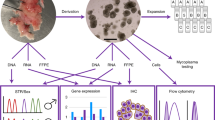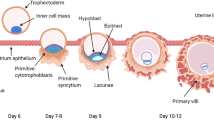Abstract
The placenta plays a critical role in the efficient delivery of nutrients and oxygen from mother to fetus to maintain normal fetal growth. Human placental development and function is a highly orchestrated process, which is spatially and temporally controlled by hormones and growth factors. Specialized epithelial cells called trophoblasts play key roles in placental exchange capacity, and their abnormal function and development contribute to many pregnancy complications, including fetal growth restriction (FGR), a condition in which the fetus does not reach its full growth potential in utero. Great variation in the anatomy and development of the placenta in animal model systems (in vivo) and 2D culture model systems of trophoblasts (in vitro) limits our ability to understand pregnancy disorders. Generating in vitro models that recapitulate the unique features of the human placenta has been challenging. Here, we describe detailed methods to isolate mononuclear villous trophoblasts (containing cytotrophoblasts and trophoblast stem cells) from first trimester placentae, and use both these and trophoblast stem cell populations that can be grown long term in a three-dimensional (3D) placental organoid culture system.
Access this chapter
Tax calculation will be finalised at checkout
Purchases are for personal use only
Similar content being viewed by others
References
Gordijn S et al (2016) Consensus definition of fetal growth restriction: a Delphi procedure. Ultrasound Obstet Gynecol 48(3):333–339
Beune IM et al (2018) Consensus based definition of growth restriction in the newborn. J Pediatr 196:71–76. e1
Barker DJP (2006) Adult consequences of fetal growth restriction. Clin Obstet Gynecol 49(2):270–283
Figueras F, Gardosi J (2011) Intrauterine growth restriction: new concepts in antenatal surveillance, diagnosis, and management. Am J Obstet Gynecol 204(4):288–300
Sun C et al (2020) The placenta in fetal growth restriction: what is going wrong? Placenta 96:10–18
Knöfler M et al. (2019) Human placenta and trophoblast development: key molecular mechanisms and model systems. Cell Mol Life Sci 76(18):3479–3496
Burton G et al (2009) Rheological and physiological consequences of conversion of the maternal spiral arteries for uteroplacental blood flow during human pregnancy. Placenta 30(6):473–482
Surico D et al (2019) Preeclampsia and intrauterine growth restriction: role of human umbilical cord mesenchymal stem cells-trophoblast cross-talk. PLoS One 14(6):e0218437
Haider S et al (2018) Self-renewing trophoblast organoids recapitulate the developmental program of the early human placenta. Stem Cell Rep 11(2):537–551
Turco MY et al (2018) Trophoblast organoids as a model for maternal–fetal interactions during human placentation. Nature 564(7735):263–267
Okae H et al (2018) Derivation of human trophoblast stem cells. Cell Stem Cell 22(1):50–63. e6
James JL et al (2015) Isolation and characterisation of a novel trophoblast side-population from first trimester placentae. Reproduction 150(5):449–462
Gamage TKJB et al (2020) Side-population trophoblasts exhibit the differentiation potential of a trophoblast stem cell population, persist to term, and are reduced in fetal growth restriction. Stem Cell Rev Rep 16(4):764–775
Korhonen M et al (1991) Distribution of the alpha 1-alpha 6 integrin subunits in human developing and term placenta. Lab Invest 65(3):347–356
Pötgens AJG et al (2004) Syncytin: the major regulator of trophoblast fusion? Recent developments and hypotheses on its action. Hum Reprod Update 10(6):487–496
Acknowledgments
This work was supported by a RANZCOG Mercia Barnes Trust Project Grant. C. Sun is the recipient of an AMRF Doctoral Scholarship (1219006).
Author information
Authors and Affiliations
Corresponding author
Editor information
Editors and Affiliations
Rights and permissions
Copyright information
© 2024 The Author(s), under exclusive license to Springer Science+Business Media, LLC, part of Springer Nature
About this protocol
Cite this protocol
Sun, C., James, J.L., Murthi, P. (2024). Three-Dimensional In Vitro Human Placental Organoids from Mononuclear Villous Trophoblasts or Trophoblast Stem Cells to Understand Trophoblast Dysfunction in Fetal Growth Restriction. In: Raha, S. (eds) Trophoblasts. Methods in Molecular Biology, vol 2728. Humana, New York, NY. https://doi.org/10.1007/978-1-0716-3495-0_19
Download citation
DOI: https://doi.org/10.1007/978-1-0716-3495-0_19
Published:
Publisher Name: Humana, New York, NY
Print ISBN: 978-1-0716-3494-3
Online ISBN: 978-1-0716-3495-0
eBook Packages: Springer Protocols




